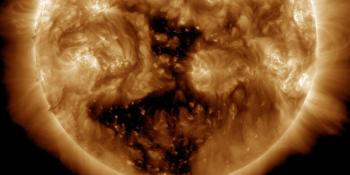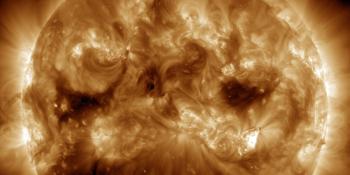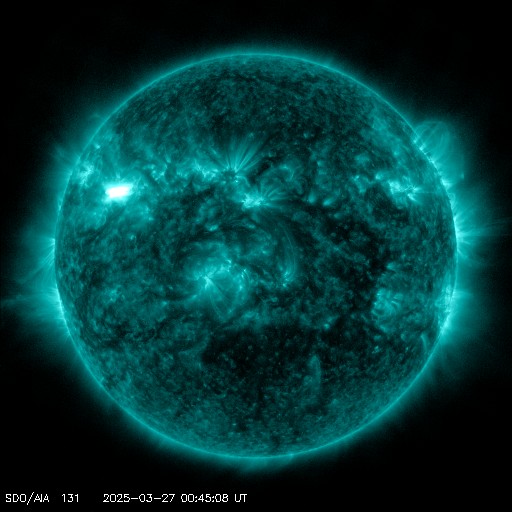Viewing archive of Thursday, 27 March 2003
Solar activity report
Any mentioned solar flare in this report has a scaling factor applied by the Space Weather Prediction Center (SWPC). Because of the SWPC scaling factor, solar flares are reported as 42% smaller than for the science quality data. The scaling factor has been removed from our archived solar flare data to reflect the true physical units.
Report of Solar-Geophysical Activity 2003 Mar 27 2200 UTCPrepared by the NOAA © SWPC and processed by SpaceWeatherLive.com
Joint USAF/NOAA Report of Solar and Geophysical Activity
SDF Number 086 Issued at 2200Z on 27 Mar 2003IA. Analysis of Solar Active Regions and Activity from 26-2100Z to 27-2100Z
Solar activity was at low levels. Region 322 (N19,
L=348) produced the two largest flares of the period, a C3.6 x-ray
flare at 27/0945Z and a C2.3 x-ray flare at 27/1455Z (both correlated
using SXI imagery). Region 321 (N05E34) has become a
beta-gamma-delta (weak) region which produced several low-level
flares during the period. Region 319 (N13W01) has shown rapid
development and has become a beta-gamma class group over the past 24
hours. Newly assigned Region 325 (N12E80-old Region 296) has begun
to rotate into view and was a large complex region on its previous
rotation. New Region 324 (S16E68) was also assigned today.
IB. Solar Activity Forecast
Solar activity is expected to be at
low levels. Regions 319 and 321 have the potential of producing
M-class flare activity
IIA. Geophysical Activity Summary 26-2100Z to 27-2100Z
The geomagnetic field ranged from quiet to minor storm levels. The
Bz component of the interplanetary magnetic field ranged from +/- 10
nT throughout the period due to a recurrent high speed stream
(approximately 525 km/s at the time of this writing). The greater
than 2 MeV electron fluxes at geosynchronous orbit reached moderate
levels today.
IIB. Geophysical Activity Forecast
The geomagnetic field is
expected to be at predominantly active levels. Minor storm
conditions are possible through day one of the interval due to a
favorably positioned recurrent coronal hole. Days two and three
should see a return to predominantly unsettled levels with
intermittent active conditions.
III. Event Probabilities 28 Mar to 30 Mar
| Class M | 30% | 30% | 30% |
| Class X | 05% | 05% | 05% |
| Proton | 01% | 01% | 01% |
| PCAF | green | ||
IV. Penticton 10.7 cm Flux
Observed 27 Mar 141 Predicted 28 Mar-30 Mar 150/155/155 90 Day Mean 27 Mar 132
V. Geomagnetic A Indices
Observed Afr/Ap 26 Mar 007/008 Estimated Afr/Ap 27 Mar 020/025 Predicted Afr/Ap 28 Mar-30 Mar 012/015-010/012-010/012
VI. Geomagnetic Activity Probabilities 28 Mar to 30 Mar
| A. Middle Latitudes | |||
|---|---|---|---|
| Active | 30% | 25% | 25% |
| Minor storm | 15% | 10% | 10% |
| Major-severe storm | 05% | 01% | 01% |
| B. High Latitudes | |||
|---|---|---|---|
| Active | 40% | 30% | 30% |
| Minor storm | 20% | 15% | 15% |
| Major-severe storm | 10% | 05% | 05% |
All times in UTC
Current data suggests there is a slight possibility for aurora to appear at the following high latitude regions in the near future
NuukLatest news
Latest forum messages
AR4043 11Large Coronal Hole 25 137Aurora photography hints for those of us with smartphones 43Photographing auroras 34More on an art than a science 3
More topicsSupport SpaceWeatherLive.com!
A lot of people come to SpaceWeatherLive to follow the Sun's activity or if there is aurora to be seen, but with more traffic comes higher server costs. Consider a donation if you enjoy SpaceWeatherLive so we can keep the website online!

Latest alerts
00:57 UTC - Solar flare
Moderate M2.05 flare
00:33 UTC - Radio Blackout
Minor R1 radio blackout in progress (≥M1 - current: M1.71)
Wednesday, 26 March 2025
23:00 UTC - Geomagnetic activity
Minor G1 geomagnetic storm (Kp5) Threshold Reached: 22:37 UTC
20:30 UTC - Geomagnetic activity
Moderate G2 geomagnetic storm (Kp6) Threshold Reached: 20:08 UTC
20:15 UTC - Geomagnetic activity
Minor G1 geomagnetic storm (Kp5) Threshold Reached: 20:00 UTC
Space weather facts
| Last X-flare | 2025/02/23 | X2.0 |
| Last M-flare | 2025/03/26 | M1.0 |
| Last geomagnetic storm | 2025/03/22 | Kp6- (G2) |
| Spotless days | |
|---|---|
| Last spotless day | 2022/06/08 |
| Monthly mean Sunspot Number | |
|---|---|
| February 2025 | 154.6 +17.6 |
| March 2025 | 135 -19.6 |
| Last 30 days | 133.8 -19.2 |






